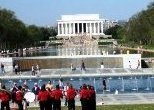Located between the Botanic Garden and the U.S. Capitol, the Capitol Reflecting Pool was originally envisioned by Pierre L�Enfant (1754-1825), the architect and engineer who designed the plan of the city of Washington DC in 1791.
L'Enfant had planned to redirect the waters of the Tiber Creek into a canal falling into a cascade and pool at the foot of Capitol Hill. This would have been one of the most important water effects with which L'Enfant intended to beatify the city of Washington DC. Although the city plan was simplified in February 1972 by Major Andrew Ellicott, it retained some of the original characteristics.
When the Washington Canal was built in 1815, it did not incorporate any of L�Enfant�s basins or cascades. It ran down 3rd Street and crossed over the Botanic Garden, but it soon became a sewer and was channeled into a sewer line in the early 1870s.
In 1900, the National Mall in front of the U.S. Capitol Building was a complete mess. A train station and railroad tracks cut across it at 6th Street, shops, buildings and other random structures obstructed the monumental sight that L�Enfant had once envisioned. In 1901, Frederick Law Olmsted Jr. (1870-1957) was appointed by Congress to the McMillan Commission, which was established to fullfill L'Enfant's vision of a monumental national capital.
The McMillan Commission designed a National Mall with reflecting pools and splashing fountains to provide a cooling environment for visitors during the hot summers in Washington DC. The McMillan Plan included eight fountains placed off the center axis in Union Square, and a large pool along the National Mall's center panel from 3rd to 4� Streets.
The McMillan Plan was later revised in the 1930s. The revised plan had simpler water effects, and most were eliminated in the final version. Also, Frederick Law Olmsted Jr.�s final plan did not include a pool. However, the Skidmore, Owings and Merrill (SOM) Plan of the 1960s revived the McMillan Plan's concept of a reflecting pool. The SOM design for the Capitol Reflecting Pool was built as part of the construction of the Center Leg of the Inner Loop Freeway, which passes underneath Union Square along the axis of 2nd Street.
Spectacularly mirroring the image of the U.S. Capitol Building, the Capitol Reflecting Pool is a complement of the Lincoln Memorial Reflecting Pool. The six-acre pool occupies over half of Union Square. The pool's longer west end has a convex curve, and the shorter east end has a concave curve that is broken by a rectangular recess in the center, on line with the Grant Memorial and the center line of the Mall. The pool�s angled sides parallel the axes of Pennsylvania and Maryland Avenues. The pool�s footprint is asymmetrical to make up for the fact that the Grant Memorial was centered on the Capitol�s west fa�ade rather than on the dome, with the result that the memorial is several feet off the true center line of the Mall.
The Capitol Reflecting Pool's broad limestone coping is rounded like a bolster on the exterior, and slopes at a 90-degree angle with a slight concave curve on the interior. The limestone has a raked finish, with numerous parallel lines. The bottom of the pool is black concrete in order to increase its reflectivity.
The Capitol Reflecting Pool is a component of a larger plaza, which includes the Grant monument and includes sunken walks along the north, west, and south sides of the pool and a wide plaza on the west side. Three broad steps lead down to the walks, which are sunk about a foot below ground level; the pool�s coping rises to about this height, so that the surface of the pool is near ground level. North and south of the Grant Monument are narrow flights of steps leading down to the pool.
The Capitol Reflecting Pool has no filtration system and is often filled with dirt and trash. Sections of the retaining wall and coping have settled, affecting the seals so that the pool is leaking water.



